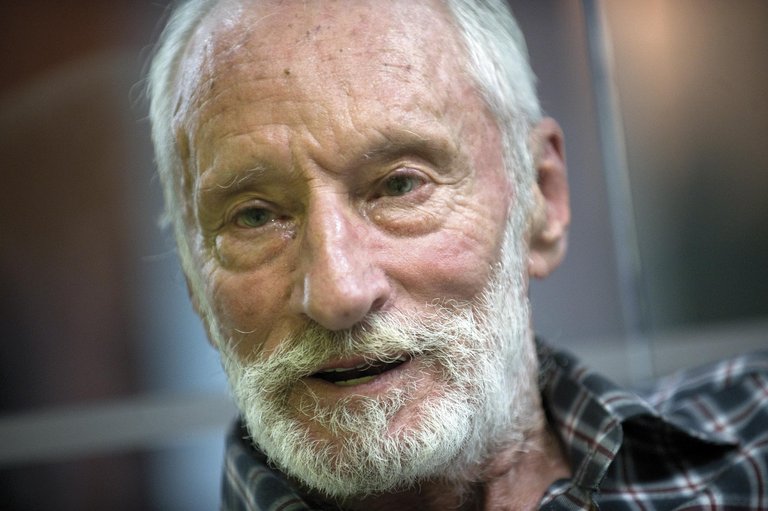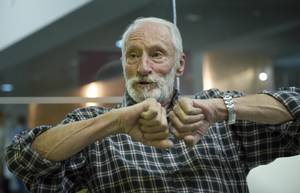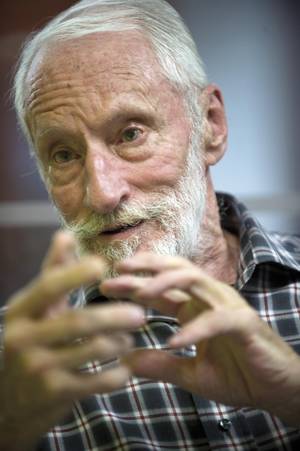"The ice has me hooked because it changes on a human scale and that allows me to witness the changes"

Adolfo Eraso says he prefers to give data than opinions. Throughout the interview, however, in addition to providing data, he has expressed his opinion on some issues. For example, he has confessed that he is not satisfied with our species, that he understands that we should be more humble, because it seems to him that we are mistreating the planet.
It attracts me to be in places where long ago there has been no one, so I want so much caving. For me it has been a very fruitful activity: I have done important research and fascinating discoveries in the subsoil, and for many years I have researched the processes that occur in the bowels of the Earth. But these processes are very slow, they take place on a geological scale.
Instead, ice changes occur on a human scale. That means I could witness those changes. That brought me to the ice and I was thrilled with what I saw and lived with those blue colors... Exploring the ice cavities is fascinating.
But, besides beautiful, as I said before, they change very quickly. You enter a hole and the following year, when you return, you find it the same, but a year later the changes are evident and the third year will seem totally different from what you knew the first time. Watching this closely is exciting.
Anyway, I still feel cardiac tremors when making speleology, descending vertically through the holes of the caves, without more than a total darkness around. But the ice has me hooked and I'm sure I'll keep pushing it into endoglacial and subglacial holes as I can.
In addition, I have confessed that I am in luck because I have two summers a year: I spend the summer here in the North Pole and now, when here is winter, I go to the South Pole to enjoy the summer there [with a naughty smile]. Well, and by the way, let's make some measurements on glaciers.
We measure the discharge of glaciers. In fact, we have realized that it is a very good meter to assess the effects of global warming, since the response is immediate: when the temperature rises a level, the discharge increases proportionally and vice versa.
We have very specific data. We started in 2001 and now we collect continuous data in both hemispheres. And we have seen that in both cases the discharge is growing, which means that it is a global process, since between the North and South stations there are more than 16,000 km. However, despite being a parallel phenomenon, it is not occurring to the same extent: In the north the discharge is between 3.5 and 4 times greater than in the South.
Why that difference? We do not know for sure, but it is logical to think that this is because in the northern hemisphere there are many more people than in the south. In addition, in the North the ice mass is smaller and is found in the sea, not on a continent.
For reasons, the data is there. And the data tells us that both in the North and in the South the loss of ice is increasing and that every year the thaw accelerates.
No, it is not easy, because any glacier does not serve to collect data. And once the glacier is chosen, probes will be placed at the bottom of the river that emerges from the glacier, will ensure that they are well, will be reviewed periodically and replaced by new ones... And that must be done on the ground. That forces us to go there.
We have a total of eight stations, four in North and South, at different latitudes and heights, to measure the influence of these factors. The oldest station is in Iceland, on the Kviarjökull glacier, at a latitude of 64ºN. Also found in the North are the Svalbard Islands, at 79°N, and in the North of Urale and the Swedish Arctic, both at a latitude of 68°N. In the south there are two in Argentinian and Chilean Patagonia, with a latitude of 49°S and 51°S; another in Antarctica, with 62°S; and the fourth in the Antarctic peninsula, with a latitude of 65°S.
Of course, in those places there is no atmosphere. Therefore, I request two things from the participants in the expeditions: one that the objective risk is minimal and two that their objectives are above the personal objectives during the expedition.
In addition to the work we do in it, there is an interpretation and treatment of the data collected.
The results are not optimistic. Also, you want to know my opinion, right? Well, I prefer not to say. In this I agree with Goether, who stated that "men will be united by their convictions and separated by their opinions." Well that.
I gave you some first data. And ice has other significant data. For example, continental ice tells us the carbon dioxide concentration the atmosphere has had over time.
In Antarctica, with perforated ice, researchers have achieved up to 800,000 years of ice, comprising 8 interglacial phases and 9 glaciations. And they have also pulled older. Now I am waiting for the results of a Chinese research, which I know they are also in it, but they have not published anything. Well yes, they would have taken something out there, in China; but in Nature or Science or in those cases nothing has yet appeared.
However, we have very old records, and analyzing the information that has been extracted so far, it is observed that the concentration of carbon dioxide has never been as high as the current one. For thousands and thousands of years it has suffered cyclical fluctuations, but the trend breaks. Do you know when? From the beginning of the industrial era. Since then it has grown steadily and faster.
So what do you want me to tell you? I am not satisfied with our species at all. The word sustainability? Shit! It only focuses on the economy, nothing on the environment. And I am not an ecologist, in any case I am an ecologist. But we are giving very bad treatment to our planet, we should be more humble.
Yes, and in that Karmenka is doing a great job through his blog: karmenka.glackma.es . It is a daily form, with photographs and videos, especially aimed at children and young people. You don't know success! There young people leave their comments and opinions, and it is to see the interest they put.
In addition to learning to love and respect the environment, they know closely the work of scientists, so the blog is a perfect tool to create vocations. For me it is fundamental.
Buletina
Bidali zure helbide elektronikoa eta jaso asteroko buletina zure sarrera-ontzian













